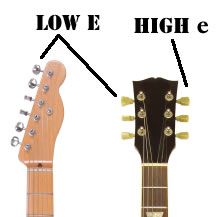Learn To Play Rock Guitar
Beginner rock guitar lessons for n00bs and rusty rockers
Change Strings - Restring an Axe?
Does your guitar sound dull? It's probably your guitar strings. Did you change strings recently? You'll find the more you play your guitar, the more you've got to change strings. In fact, it's the most common guitar maintenance task you will have.
Your guitar strings start to sound dull and flat because of a few different factors. The first is the fact that you are stretching the string to get the proper tuning. Over time the stretching will help to wear the string out.
But on top of that, the oil from your fingers and hands will dull the strings. Other environmental factors can be temperature, smoke and humidity (moisture in the air). All of these contribute to wearing those strings out and making them sound like crap.
So change 'em already! It's a really easy process – here's the instructions for re-stringing your guitar. You can change strings with these different brands. Check out the strings rock stars use.
To change strings on a guitar, first you need to remove the old ones. Start by loosening the strings with the tuners until the strings are totally slack. Either pull them out of the post holes at the tuners or take some wire cutters and clip the strings at the tuner posts. This will leave you with a nice straight length of wire – I usually take all six strings off and bunch them together to wind in a coil. This makes for easy disposal.
Pull the remaining wire from each tuner post and throw it out. This is a good time to polish your guitar and neck. You can buy guitar polish online or at the music store, but I usually just use a good furniture polish to bring the shine back and clear out the dust. Clean it up and grab the new set of strings. The package should have six new strings of varying gauges.
I usually start with the thickest string first (low E) and work my way up to the thinnest string (high e). There's no right or wrong way here. Just make sure you install each string in order from thickest to thinnest OR thinnest to thickest. It can be easy to get mixed up the first few times when you change strings…
Start at the guitar body and thread the un-balled end through the bridge unit. On some guitars you'll have a bar stop, on others you'll thread the string up through the body. Some others will have a tremolo unit that requires a different stringing method. Check with your manufacturer on the best way to string your guitar.
Thread the string through the small hole in the post of the machine head (tuner). Eyeball about an inch (about 2.5 cm) of extra string length beyond the post and make a 90 degree bend in the string. This is important - when you change strings you need to make sure there's enough wire on the end to keep the string from slipping.
If you cut it too short, you'll end up having to replace the string, as it just won't stay tuned because it keeps slipping. Once the bend is made, draw the string back through the post to the bend and begin to wind the tuning peg.

Wind it so the bend in the string is rolling away from the nut. Depending on which side of the headstock the tuning pegs of the machine heads are located, you'll wind the strings clockwise or counter-clockwise. OK, that's a little confusing. So look at it this way: if the pegs are on the "low E" side of the headstock, wind counter-clockwise; if on the "high e" side, wind it clockwise.
As you are winding the peg, keep some tension on the string so it doesn't uncoil itself. As the string coils around the post of the tuning machine, keep the coils nice and tight on the post to create a solid wrap.
Once the string begins to tighten, make sure the it is lined up on the saddle and on the nut in the correct spot. Tighten the string so it is taught, then slip a couple fingers between the string and the fingerboard and pull up away from the fingerboard to stretch the string. Re-tighten the string and repeat the stretch.
It will take a few stretches until the string is ready to hold its pitch. You just have to get the string used to its new tension. You will also have to adjust the tuning a couple times until the strings are happy.
Repeat the process for the rest of the strings, and voila! You have just restrung your guitar. Not too difficult a process to change strings, now, was it? Here's the videos that highlight some different techniques. I've also added a video that shows you an easy way to change strings when you have a Floyd Rose tremolo unit.
Bar Stop Restring Technique
Complete Restring Technique
Easy Floyd Rose Tremolo Restring Technique
|
|

